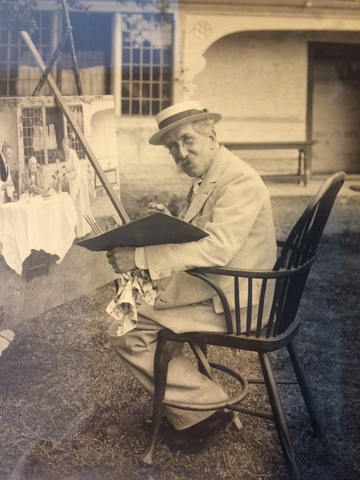
It is difficult to categorise today’s featured artist. It is difficult to compartmentalise his style of paintings. He is a genre painter. He is a satirical painter. He is a humourist painter. I suppose the closest one comes to liken him with a famous artist is that his paintings have a soupçon of the 18th century works of William Hogarth. Let me introduce you to the 19th century English painter Walter Dendy Sadler.

Walter Dendy Sadler was born on May 12th, 1854 in the Surrey market town of Dorking, which lies some twenty miles south of London. He was the son of a solicitor and attended school in Horsham. During his school days he developed a love of sketching. Walter decided that in the future he wanted to follow an artistic path and become a professional painter and so he took some local art tuition. In 1870 at the age of sixteen he left Horsham and enrolled at the prestigious Heatherly School of Fine Arts in London. In 1871 he went to Germany and received private tuition from Wilhelm Simmler and studied under the English genre painter, James Moulton Burfield
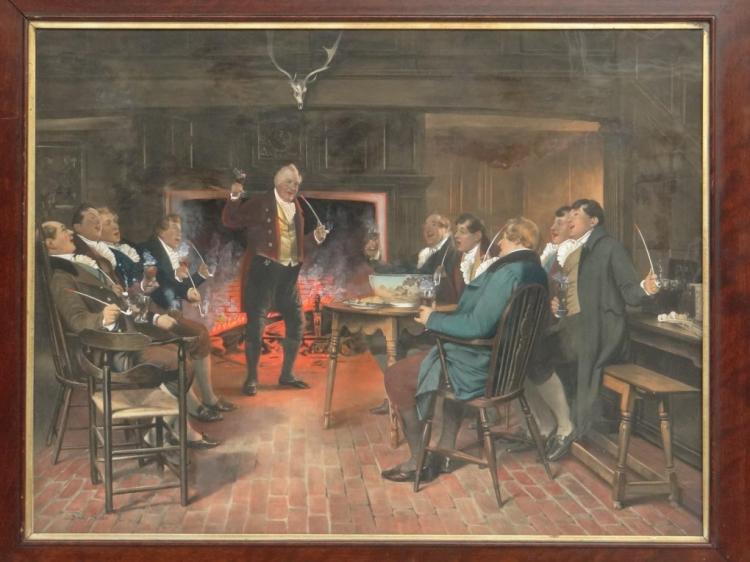
He was barely eighteen years of age when he first exhibited his work at the Dudley Gallery in 1872 and a year later his work was exhibited at the Royal Academy. He continued showing at the R.A. from 1873 into the 1890’s. Although young, Sadler often portrayed elderly people in his early submissions to the Royal Academy, such as The Old Squire and The Young Squire (RA exhibition 1887), Old and Crusted (RA exhibition 1888), and The Young and the Old (RA exhibition 1898). In Daniel B. Shepp’s 1905 survey Library of History and Art Dendy was praised by critics for his “close sympathy with human life in its many phases, and a keen appreciation of its spirit, whether humorous or pathetic”.

Sadler’s works of art were extremely popular in both Europe and America. In the magazine Good Housekeeping in 1912 a profile of the artist claimed that:
“…Few American homes contain no reproduction of Dendy Sadler’s studies of pre-Victorian middle-class life”
Prints of his work sold in the millions in the United States, with original canvases fetching prices in the thousands of dollars. In the same magazine Sadler explained why he liked to depict elderly people in his works. He wrote:
“…I have been asked why so often I choose old people to smile and frown and think in my compositions. To me, the dignity of old age is most appealing. To me, the pathetic beauty of the autumn of our years is more stirring than the senseless impatience of youth and the heat of our amorous summers…”

The subject of his paintings were contemporary people shown in domestic and daily life pursuits. The depictions of the people would often have comical expressions and sometimes pointing out their greed, foolishness etc. The figures depicted in his paintings were usually set in the late eighteenth or early nineteenth centuries, often with sentimental, romantic, and humorous themes. Sadler was known for his elaborate staging of his paintings.
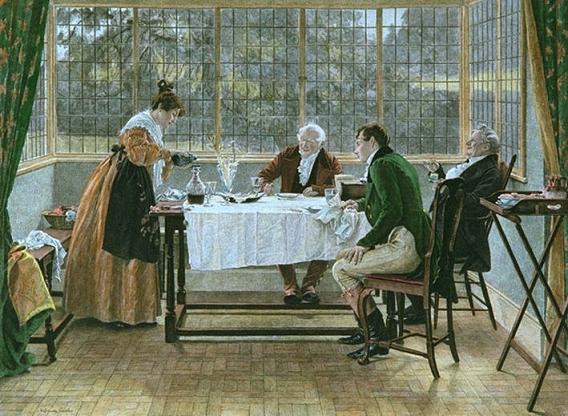
Before painting a scene, he would create elaborate settings in which local villagers would often pose as models. Indeed, as he often used the same props and models, these can sometimes be seen repeated in successive paintings in different guises. The home, the monastery, the inn, the lawyer’s office, the garden, and the golf course all provide subjects for his wit and clever social scrutiny. All would be dealt a dose of his wit and his clever observation.
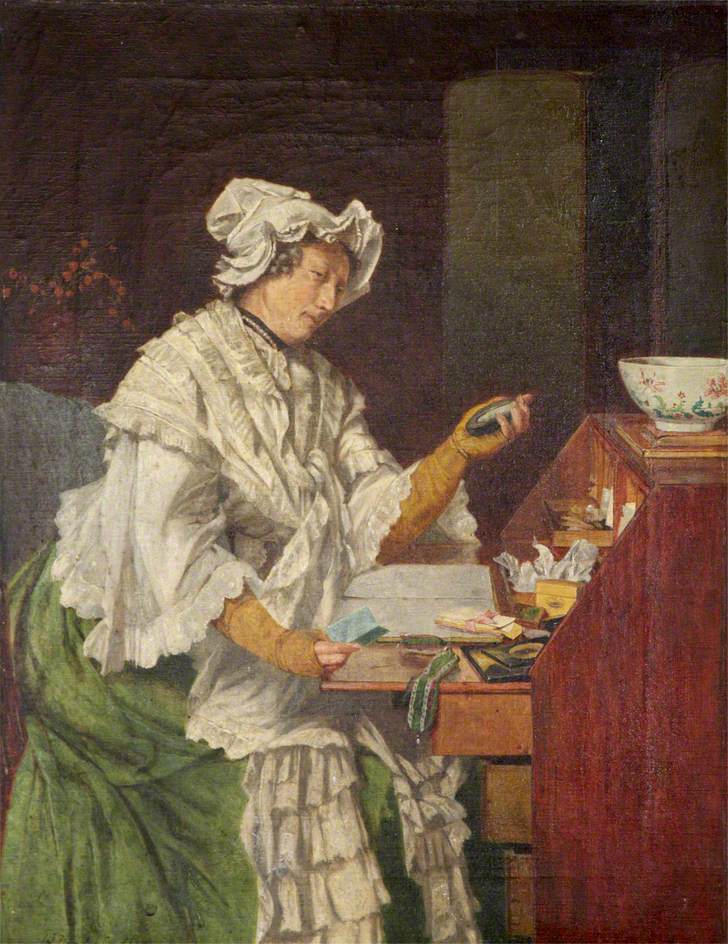
Sadler was lauded for his works of art and he achieved greater popularity with the general public. The paintings reminded people of bygone days of charm and culture and are hailed as being as fresh today as the day he painted them. People who liked the delicate feeling expressed in Sadler’s works flocked to own one of his works or a print of them. It was not just the sentimentality of these “old-time” paintings that appealed to thousands of buyers but it was also his artistic talent.
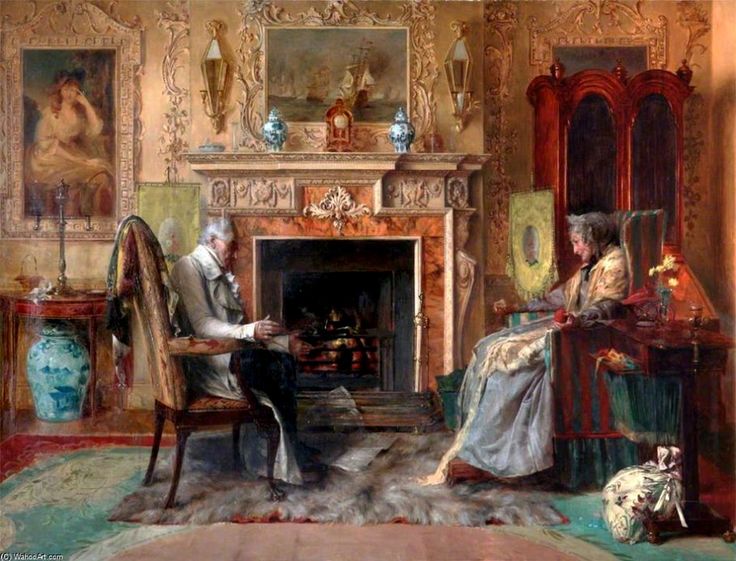
His submission to the Royal Academy jurists for their 1896 exhibition was a painting entitled End of the Skein. The setting is a well-appointed sitting room. To the left is an elderly gentleman seated in a padded mahogany chair draped with a paisley Kashmir shawl and across from him we see an elderly lady seated in a striped armchair, whom we perceive to be his wife. Both sit before a warming fire. The couple are examples of “good old age” living, both independent and leading a productive life. They sit working together to make a skein of red yarn into a ball, ready for knitting. It is a sign of loving co-operation between the couple. So, what do we deduce from the portrayal of the two figures? What do you think? I would suggest they are of upper-middle or upper-class status, and their financial status that goes with this class of person would have some relevance on their life expectancy, their comfortable living, and they would probably command great respect from their family. Not just respect but loving care. This refined couple had a greater life expectancy than most as their secured economic status would have allowed for a healthier diet, a peaceful and contented lifestyle, and higher standard of living and with this came a higher life expectancy. The elaborate setting for the painting with its abundance of ornaments and painting in some ways takes us away from the couple and has us carefully scanning the room itself. However, they are pointers to the wealth of the couple, who seemed to be unburdened by the various financial pressures and consequences of poverty. The mantel above the fireplace is decorated with a naval scene hanging in an ornate frame behind a fine-looking clock, on either side of which we see a couple of matching blue and white Chinese jars.
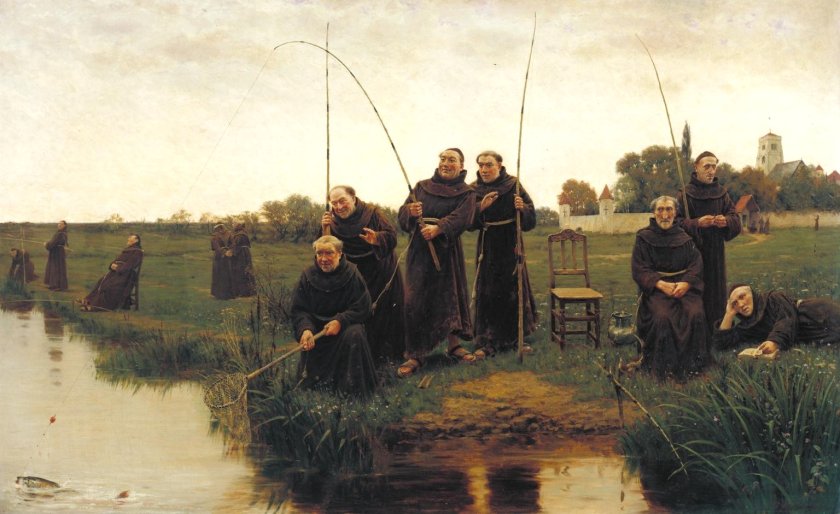
Many of Sadler’s humorous paintings featured monks, and monastic life. In his 1880 painting, Thursday, which is also known as ‘Tomorrow will be Friday‘, he depicts a group of Franciscan monks fishing. These friars were forbidden to eat meat on Fridays, as a reminder that Friday was the day when Christ was crucified. Sadler wrote about the depiction:
“…The background was made up from studies I had painted in Germany, with the help of some foreground studies made in the previous summer at Hurley on the Thames…”
This painting can be found at Tate Britain. It was one of three paintings that commenced Sir Henry Tate’s collection.
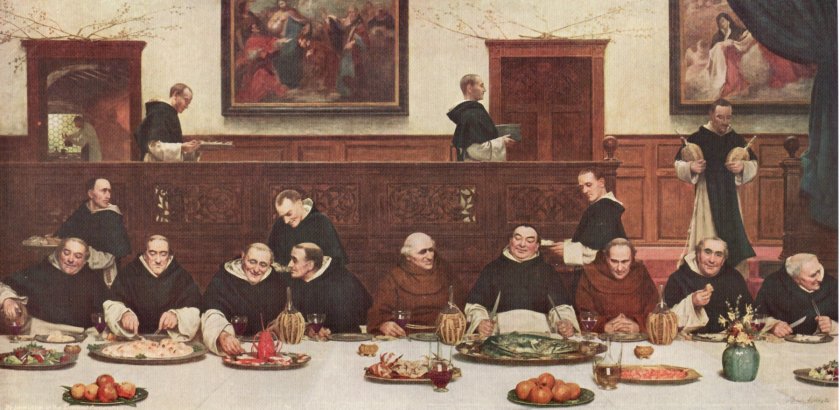
A pendant to this picture, painted two years later in 1882 and entitled Friday hangs in the Walker Art Gallery, Liverpool. This work shows the abbot and the monks at dinner on Friday enjoying their meal of fish which had been caught the previous day and was in lieu of the prohibited meat. Each side of the jovial looking abbot are monks from another monastery, hence the different coloured habits. The painting was exhibited at the Royal Academy show in 1882 but received scant attention, probably due to being placed high up on a wall. This fact was commented on by a writer in the Art Journal who stated:
“…A good picture, which would have done much to make its author had it received better treatment from the hangers…Several of the minor details, such as the excessively modern appearance of the table and its furniture, might be criticized; but on the whole the picture is to be praised for its genuine humour, and for the careful solidity of its execution…”
Sadler talked about his painting, Friday saying:
“I can recall no reason why I tried to paint monks, but I do remember that I never had a real monk as a model. I have studied them on the Continent, also at a small monastery in Crawley, Sussex…… The figures to the right and left of the abbot are monks of the order of St. Francis, their habits are brown; the other monks are of the order of St. Dominic, and their habits are black and white…”

Once again older men featured in Sadler’s 1886 painting A Good Bowl of Punch. Before us, we see three cheerful gentlemen seated around a table, one is peeling an orange into a bowl of rum, whilst the other two, who are holding their long-handled pipes, watch on intently. The setting is a bright panelled interior with its English type carvings.

I particularly like his painting entitled The Village Postman. Sadler painted during the reign of Queen Victoria and during this period, nostalgic and romantic scenes were favoured by the buying public. Look at the work and make up your mind what is going on. He has been doing his round on a horse. This picture is part of a Victorian fashion for nostalgic and romantic scenes showing life a hundred years before. The postman appears to have come by horse as he has a riding whip tucked under his left arm. He is sorting out the mail in front of the girl. She clasps her hands nervously. Could it be that she is expecting a letter from her lover?
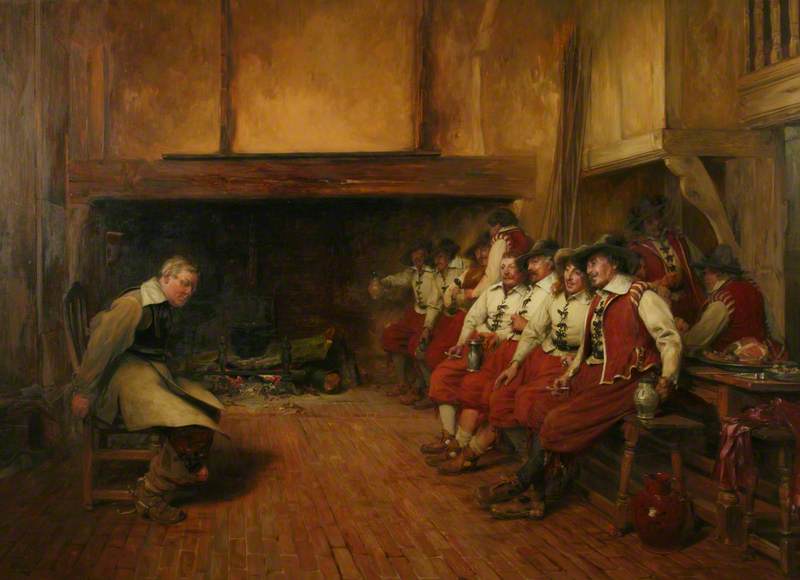
One of Sadler’s paintings has a strange title and one I am at a loss to understand. Any ideas ???
The title is In the Camp of the Amalekites. In my search to understand the relevance of the title. The Encyclopædia Britannica states:
“…Amalekite, member of an ancient nomadic tribe, or collection of tribes, described in the Old Testament as relentless enemies of Israel, even though they were closely related to Ephraim, one of the 12 tribes of Israel. The district over which they ranged was south of Judah and probably extended into northern Arabia. The Amalekites harassed the Hebrews during their Exodus from Egypt and attacked them at Rephidim near Mount Sinai, where they were defeated by Joshua. They were among the nomadic raiders defeated by Gideon and were condemned to annihilation by Samuel. Their final defeat occurred in the time of Hezekiah…”
But what have the Amalekites to do with Sadler’s painting which features a Parliamentarian soldier (a Roundhead) who is being held captive by a group of Royalists. Roundheads were the supporters of the Parliament of England during the English Civil War which lasted from 1642 to 1651. The Roundheads, also known as Parliamentarians, fought against King Charles I of England and his supporters, known as the Cavaliers or Royalists, who claimed rule by absolute monarchy and the principle of the ‘divine right of kings’. The setting is an interior with wood-timbered walls and floor. On the left we see a Roundhead prisoner bound to a chair. Opposite him are a row of Royalist soldiers seated along a bench. The Royalists are all wearing their uniform of a white shirt with red breeches. Some are wearing red waistcoats and hats. They have just eaten a meal as on the table on the far right behind the bench bears the remains of the meal.

Walter Dendy Sadler died in the small Cambridgeshire village of Hemingford Grey on November 13th 1923, aged 69. He had moved to the village in 1897 and lived at River House .
